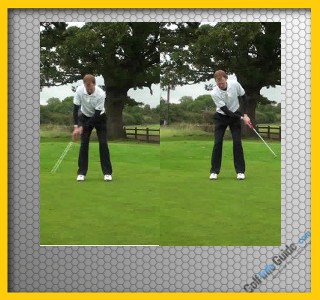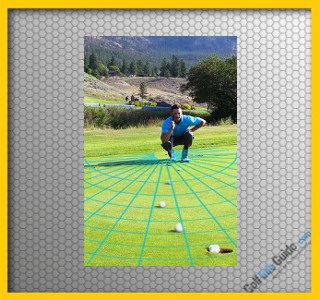- When rain comes down, the greens are going to slow down quickly. Even if you don’t see any standing water between you and the hole, it is a safe bet that the greens will be losing speed as rain continues to fall.
- Wind, on the other hand, it likely to cause green speeds to increase during the day. When wind blows on a dry day, it will pull moisture out of the grass, causing the greens to be quicker. If you tee off early on a windy day, expect the greens speeds to pick up consistently throughout your round.
- If you are dealing with heat during your round, the effect that the heat has on the speed of the greens may be a little complicated. Early in the day, that warm air is going to dry out the greens and they should speed up. However, as the day wears on, the grass may begin to grow quite rapidly, causing the greens to slow down instead. So, when playing in warm weather, be sure to watch the putting surfaces carefully as you go, and adjust your approach to your putts accordingly.
Have you ever heard another golfer say that they were satisfied with their putting? Probably not. Putting is one of those parts of the game that seems to be the source of endless complaints, as all golfers would like to see the ball fall in just a bit more often. Of course, it is easy to see why – more than any other part of the game, putting is directly responsible for the score that you write down on the card after each hole. Making just a few more putts over the course of a round is a big deal in terms of your final score, so paying close attention to this key skill is in your best interest.
On the surface, it doesn’t seem like putting should be particularly difficult. You only have to roll the ball a short distance, you don’t have to make a big or powerful swing, and the ball doesn’t even need to get up off the ground. However, as you already know, putting is much more difficult than it appears at first. You have to bring together a variety of skills into one cohesive package if you are going to putt well on a regular basis, and that is a task which requires significant practice and plenty of focus. A partial list of the skills you will need on the greens includes green reading, speed control, an accurate stroke path, steady performance under pressure, and more. If just one of those elements goes missing on any given putt, the ball is likely to stay out of the hole.
To help you raise your putting performance to its highest possible level, we have compiled the following list of ten putting tips. These are some of the best tips you can receive with regard to your performance on the greens, so consider each one carefully before moving on to the next. Let’s get started!

To make putts on a consistent basis, you have to control your speed beautifully – it’s just that simple. Sure, you need to pick the right line as well, but your putts aren’t going to go in if they are hit with the wrong speed. Worse, if you are way off with your speed control, you might not even make your next putt, quickly turning the hole into a disaster on the scorecard.
While you would love to have both the line and speed right on each putt, it is actually more important to nail the speed if you are only going to get one half of the equation correct. A putt that is off line is unlikely to miss by more than a foot or two. On the other hand, a putt with the incorrect speed can easily come up several feet short or run several feet long. Think about the last few times you have three putted and you will probably notice that most of those three putt greens were the result of poor speed control more than anything else.
There are a couple of ways in which you can work on improving your speed control on the course. The first is through a proper warm-up session before your round begins. Make sure to give yourself enough time to hit some practice putts across the putting green prior to heading to the first tee, as this is your best chance to learn the speed of the surfaces for the day. Don’t just hit short putts, either – find an open stretch on the putting green and roll some putts from one side to the other in order to judge the speed properly before you start your round.
The other way you can improve your speed control is by actually reading the speed of each putt you face. Most golfers understand that they need to read the line, but far fewer take the time and effort to read the speed. Specifically, you need to check the slope of the ground around the hole to see if the putt is uphill or downhill at the end. Only when you have a clear picture of the slope that you are facing on a given putt will you be able to decide properly on how much speed to give the ball at impact. No golfer is able to control the speed of his or her putts with 100% consistency, but a good warm-up session and paying attention to the slope of the ground will help you to make nice progress.

One of the key fundamental points to keep in mind while putting is the fact that you should maintain a light grip pressure on the handle of the club throughout your stroke. Since you are only swinging the club a short distance at a relatively slow speed, there is no need for a tight grip. Relax your fingers, let the putter hang naturally from your hands, and put the control of the stroke into your arms and shoulders.
If you are having trouble making a stroke that includes light grip pressure, try practicing your stroke using just one hand at a time. Roll a few putts while only your left hand is on the putter, then switch and do the same thing with your right. When you only have one hand to swing the club, you will quickly find that you need to rely more on your shoulders to control the motion of the stroke. After hitting a few putts with each hand, put them back together on the grip while focusing on light pressure and a smooth action. When done correctly, the putter will feel like it is simply rocking back and forth without any interruption from your hands or wrists.

When most amateur golfers set aside some time to use for golf practice, they almost always head to the driving range to swing away at a bucket of balls. Of course, there is nothing wrong with working on your full swing, but there always needs to be time left over to work on your short game as well. In fact, if you only have a limited amount of time to practice and you have to pick one or the other, opting for putting practice over the driving range is the best way to go.
It is important to practice your putting as frequently as possible because putting is a skill that is based on feel and touch. You can’t maintain your feel and touch on the greens if you don’t practice, so the quality of your putting will quickly deteriorate after a period of inactivity. Your golf swing will come back surprisingly quickly after you haven’t played for a while, but the same cannot be said of your putting. Not only do you need to practice your putting if you wish to improve, but you actually need to practice putting to at least maintain your current level.
Fortunately, you don’t have to spend hours on end standing on the practice putting green in order to make progress. Even just spending 10 or 15 minutes working on your stroke and your speed control is enough to make a difference, although more would obviously be better. The best thing to do for your game as a whole is to create a practice plan that you can use to divide up your time efficiently while practicing. For instance, if you have one hour to practice, you could putt for 20 minutes, hit shots for 20 minutes, and chip for 20 minutes. In the end, you will have given your entire game a workout, and you will be a better player for the effort.

You will rarely face a straight putt out on the golf course. Sure, you do come across straight putts from time to time, but most of your putts are going to have at least a slight break in one direction or the other. When you do face a breaking putt, one of the key pieces of your read should be adjusting the ‘center’ of the hole mentally to pick out the appropriate entry point for your ball to fall into the cup.
What does that mean? Basically, you aren’t going to try to make the ball fall in over the front edge as you see it from where you are standing, but rather you are going to aim for the part of the hole that will be the front as the ball is breaking. This concept is better explained through the use of an example. Picture a 15-foot putt that is going to break significantly from right to left. If you hit a perfect putt, the ball is going to fall in from the high side (from the right), as the ball will be turning left quickly as it loses speed. You should be aiming for that high side as you take your read, rather than aiming for the front edge (the edge that is found on a straight line between your ball and the cup).
This point might seem like a subtle one, but it can make a big difference when it comes to allowing for enough break on your putts. Picture the ideal entry point for every putt that you face, and then work backwards to the ball until you have a great read in mind.

Club fitting is a big topic when it comes to the full swing clubs, but many people ignore it when it comes to the putter. This is a big mistake. You need to be using a putter that fits you properly if you want to make a solid stroke time after time. Swinging the putter directly down the target line is going to become much easier when you have the right club in your hands. Both the length of the putter you use and the lie angle of that putter can have a major impact on the overall profile of your stroke. If you decide to have yourself fitted for a putter, be sure to work with a professional who has specific experience in this area.

#6 – Position Your Eyes Correctly
The information that your brain is receiving from your eyes is going to go a long way toward the stroke you are able to make while standing over the ball. Since the putting stroke is so much slower than the full swing, and since you are standing so much closer to the target when putting, you are able to take in more visual information before and during the stroke than you can with a full shot. This can be both a blessing and a curse, depending on your perspective.
To make sure you are getting good information, take care to position your eyes directly over the ball at address. By getting your eyes out over the ball (and the target line), you will have a clear view of the path you need to follow in order to send the ball on its way accurately. In order to get your eyes in position, you will likely need to tilt your upper body by using your hips while maintaining plenty of flex in your knees. Once you get comfortable in this position, you should find that it gives you a great view and also makes it possible to produce a quality stroke.

There is no ‘shot clock’ in golf, leading many players to think they should take as much time as necessarily in order to get their read just right before they putt. While it is true that you want to take your time in order to get a good read, taking too much time can be just as damaging as taking too little. At some point, continuing to read the green is just going to lead to an overload of information, and you will begin to get in your own way as a result. It is a better plan to simply read the green by taking a couple of looks, decide on your path, and step up to the ball. Having a confident and decisive attitude is going to go a long way on the greens, and the group behind you will appreciate the time savings as well.
This concept also applies when you are standing over the ball waiting to start your stroke. It is easy to freeze up at this point, as you begin to get nervous about potentially missing the putt. To make sure you don’t freeze at address, use a look up at the hole to trigger the start of your stroke. The process is simple – take your stance while looking down at the ball, look up once and the hole, and then look back down to the ball. As soon as your eyes get back to the ball, the stroke starts. As long as you stick with that system, there will be no concern about standing over the ball too long.

#8 – Adjust to Conditions Quickly
Many golfers are consistently surprised by how quickly changing weather conditions can affect the speed of the greens. To play well, you need to be able to adapt to changing green speeds on the fly, as it is easy for weather to alter how fast or slow the grass is going to roll. The list below is just a partial collection of the conditions you need to watch for as you play.
The specific dynamics that you find in greens is going to depend on where you play, the time of year, the weather that day, and more. The best thing you can do is to pay close attention to any changes that are taking place so you can adapt as quickly as possible.

Okay – so you’ve heard this one before. Still, despite the popularity of this tip, it needs to take a place on our list simply because it is so important to your success while putting. More than any other shot you hit on the course, a putt is all about precision – and it is extremely hard to be precise when your head is moving around from side to side (or up and down). Think about anything else you do in life that requires precision and it is a safe bet that your head is not moving at during that activity.
If you tend to have trouble keeping your head down during your putting stroke, try focusing your eyes on a specific spot on your golf ball as the putter swings. Draw a unique marking on your ball and then place that marking skyward prior to setting up over the putt. While the putter goes back and through, keep your eyes in place and don’t let them deviate until the ball is gone. As long as your eyes stay focused on that specific spot, it is a safe bet that your head will remain still as well.

This is perhaps the best putting tip of all. Believe it or not, one of the very best things you can do for your putting is to tell yourself that it is okay to miss. In fact, you can take that a step further – missing is inevitable. Every golfer misses at least one or two putts in every single round, and usually many more than that. For example, if you finish a round with 28 putts, you have done a pretty good job on the greens by most standards. However, that means you still missed 10 putts (while making 18). So, obviously, you shouldn’t expect to make every putt that you face.
By understanding that it is okay to miss, you can free yourself up to make a quality stroke without placing so much emphasis on the results. In reality, you don’t even control everything at play when it comes to a putt either falling in or staying out. You could make a great stroke only to have the ball hit a small bump in the green between you and the cup. Or, a gust of wind could come up as your ball is rolling, causing the putt to just miss off the edge. Since you don’t have total control, the best approach is to relax, make a smooth stroke, and hope for the best.
Putting is always going to be a significant challenge, and it is often going to be a frustrating part of golf. However, you can work to get better over time, especially if you take the ten tips above to heart. Make sure to provide yourself with plenty of practice time to improve on both your stroke and your green reading skills, and be sure you have the right putter in your hands to fit your mechanics nicely. By being well-prepared before you ever head to the first tee, you can look forward to a future filled with many great putts.





